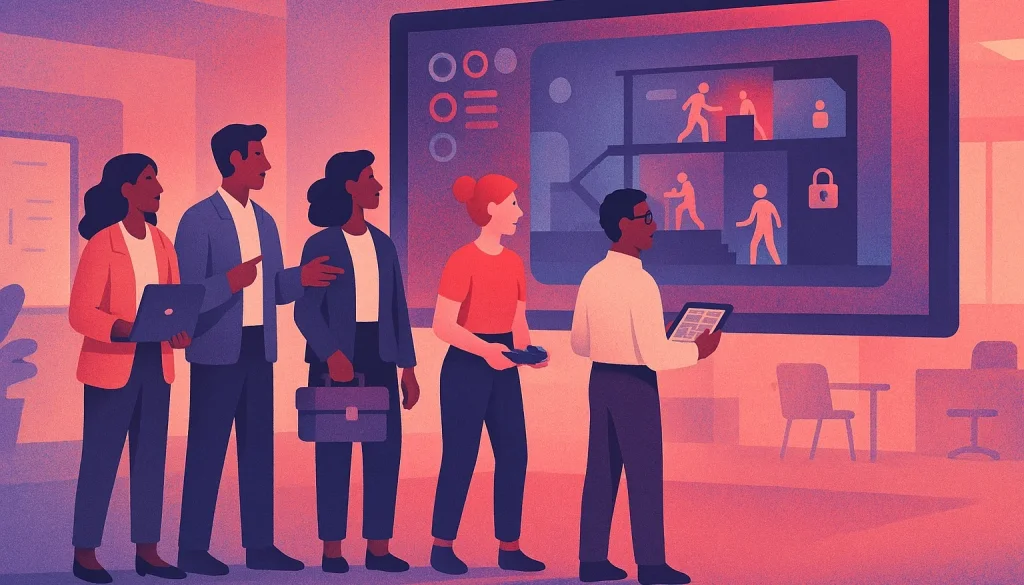Teamwork skills learning models

From tension to shared performance
High-performing teams aren't born, they're forged by navigating complexity and turning potential friction into shared capability.
CinQ uses proven frameworks within an immersive simulation to accelerate this journey, making teamwork dynamics visible, coachable, and ready for real-world execution.
The 5 dimensions of teamwork
Evolved from foundational research on team dynamics, this framework identifies the core behaviors essential for effective collaboration in high-stakes, AI-integrated environments. With this model at its core, CinQ provides a clear roadmap for capability activation, focusing proactively on the positive attributes that underpin successful team execution rather than just diagnosing issues.
We use the CinQ simulation to make related team behaviors visible under realistic operational conditions. In turn, this allows coaches to provide immediate, targeted, feedback during the simulation, helping teams actively build the specific capabilities needed to enhance alignment and performance in their actual work.
![[The 5 Dimensions of Teamwork]
Dysfunctional team (from bottom to top / largest to smallest):
- absence of trust
- fear of conflict
- lack of commitment
- avoiding accountability
- inattention to results
Cohesive team (from bottom to top / largest to smallest):
- trust
- conflict
- commitment
- accountability
- results.](/images/charts/dimensions-of-teamwork-sm.svg)
![[The 5 Dimensions of Teamwork]
Dysfunctional team (from bottom to top / largest to smallest):
- absence of trust
- fear of conflict
- lack of commitment
- avoiding accountability
- inattention to results
Cohesive team (from bottom to top / largest to smallest):
- trust
- conflict
- commitment
- accountability
- results.](/images/charts/dimensions-of-teamwork.svg)
![[The 5 Dimensions of Teamwork]
Dysfunctional team (from bottom to top / largest to smallest):
- absence of trust
- fear of conflict
- lack of commitment
- avoiding accountability
- inattention to results
Cohesive team (from bottom to top / largest to smallest):
- trust
- conflict
- commitment
- accountability
- results.](/images/charts/dimensions-of-teamwork-sm.svg)
![[The 5 Dimensions of Teamwork]
Dysfunctional team (from bottom to top / largest to smallest):
- absence of trust
- fear of conflict
- lack of commitment
- avoiding accountability
- inattention to results
Cohesive team (from bottom to top / largest to smallest):
- trust
- conflict
- commitment
- accountability
- results.](/images/charts/dimensions-of-teamwork.svg)
The skills learning process
![[The Skills Learning Process]
[X-axis: teamwork skills / Y-axis: difficulty of challenge]
Comfort Zone:
- very low teamwork skills, very low difficulty of challenge: "forming".
- low teamwork skills, low difficulty of challenge: "pressure".
Learning Zone:
- average teamwork skills, average difficulty of challenge: "iteration".
- high teamwork skills, high difficulty of challenge: "workflow".
- very high teamwork skills, very high difficulty of challenge: "adjourning".](/images/charts/skills-learning-process.svg)
Based on Tuckman's models of group development, this graph maps the typical journey teams take as they mature from initial formation to high performance. CinQ is built using this journey as an active skills-learning process, highlighting the capabilities needed to navigate each phase — especially the critical "Storming" (Pressure) period where challenges reveal opportunities for growth.
CinQ scenarios are designed to accelerate teams through these developmental stages in a compressed timeframe: observing how a team handles ambiguity (Forming), manages disagreement (Storming = Pressure), establishes workflows (Norming = Iteration), achieves synergy (Performing = Workflow), and eventually concludes its task cycle (Adjourning), provides rich data for targeted coaching.
Understanding this research-backed process allows CinQ to turn the natural friction of team development into a catalyst for building crucial skills like adaptability, conflict resolution, and shared accountability. It provides context for the simulation experience, ensuring teams develop the resilience and collaborative intelligence required for sustained performance in complex, AI-driven operational settings.